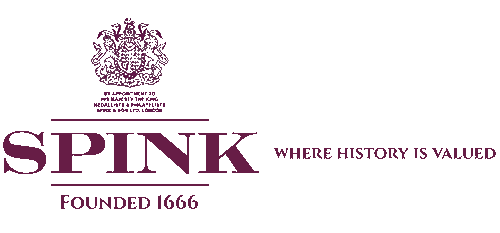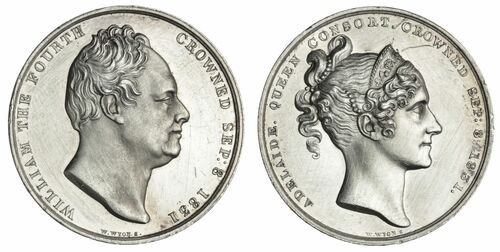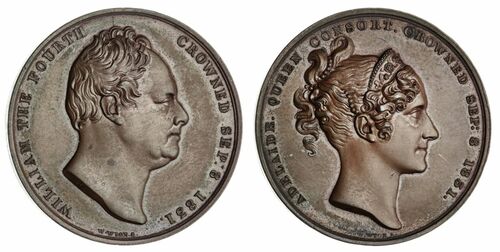Auction: 23148 - A Specialist Auction in Celebration of Their Majesties King Charles III and Queen Camilla - e-Auction
Lot: 13
Coronation of William IV and Queen Adelaide, Official Medals, 8 September 1831, by William Wyon for the Royal Mint (2), in silver, WILLIAM THE FOURTH - CROWNED SEP : 8 1831 •, bare head right, rev. ADELAIDE • QUEEN CONSORT • CROWNED SEP : 8 1831 • diademed head right, 34mm, 18.11g (Eimer 1251; BHM 1475), heavily cleaned and scratched above diadem, yet residually brilliant, struck details about extremely fine; additionally, in copper, WILLIAM THE FOURTH - CROWNED SEP : 8 1831 • bare head right, rev. ADELAIDE • QUEEN CONSORT • CROWNED SEP : 8 1831 • diademed head right, 34mm, 19.28g (Eimer 1251; BHM 1475), traces of verdigris on edge and some residual lustre to dark chocolate brown surfaces, about extremely fine (2)
Provenance
i) 'CA', by private treaty, 1985 - £30
ii) 'IF', by private treaty, 1985, £10
The Coronation medal of William IV departs heavily from the concept of those that had come before. The obverse inscription is given in plain English for the first time, and Queen Adelaide features on the reverse - the first time a single medal had been made for the Sovereign and his Consort. This lot offers the chance to own both a silver and bronze example of the medal, the former subject to a scramble inside the Abbey, the latter available for sale to the public.
Due to George IV's elaborate coronation receiving great public backlash, his successor opted for a heavily stripped back ceremony. Its austerity would lead to it becoming known as the 'Penny coronation' or 'Half Crown-nation'. In fact, the King, who had an innate dislike of ritual and ceremony anyway, had wanted to do away with a Coronation altogether, but conceded that it was a constitutional necessity. The 'cut-price' event, only cost £30,000, just over a tenth of the cost of his late brother's. William's insistence on saving money signalled the end of many ancient and symbolic acts. Gone was the Coronation banquet, the King's Champion's gauntlet challenge, and the girding of the sword, none of which have returned. In its place, the surviving rituals established much of what remains to this day.
In spite of this, the Coronation still lasted four hours, the King unusually dressed in his admiral's uniform rather than ceremonial robes, Queen Adelaide in a white and gold dress. During the return procession, for which they used the Gold State Coach (used for every Coronation since), a very heavy bout of rain descended. The wind howled, tearing canopies and drove carriages away. Nevertheless, spirits were not dampened. The crowds were in good humour, happy to see the new King. They warmed to his humility and enjoyed the opening of The Mall that same evening.
Spink wishes to thank Ella Mackenzie for the investigative historical research
Subject to 20% VAT on Buyer’s Premium. For more information please view Terms and Conditions for Buyers.
Sold for
£200
Starting price
£120







